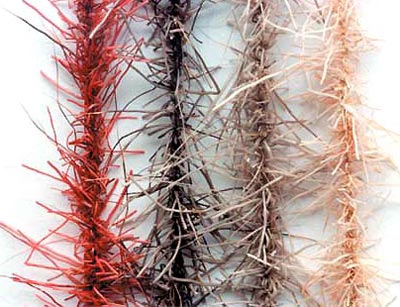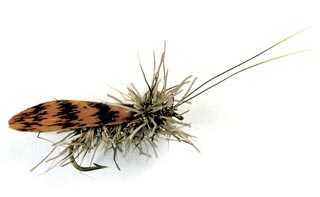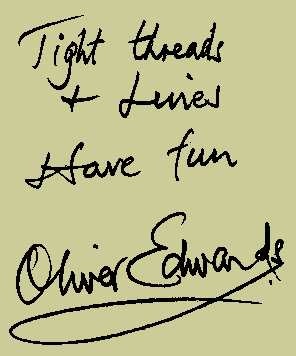
Detail of Oliver Edwards Caddis Legs

FIG 1. At bend of hook tie in a length of „O. E. CADDIS LEGS“. Spiral tying thread up hook shank to 3/4 shank position.

FIG 2. Wrap on „OE CADDIS LEGS“ in touching turns to hanging thread, and tie off securely at that position. Do not cut off excess „OE CADDIS LEGS“.

FIG 3. Trim „OE CADDIS LEGS“ as shown. The angles given are approximate and for guidance only.

FIG 4. From a roll of clear adhesive tape peel off approx. 2“ (5 cm) of tape. Take selected feather and lightly position it across tape, good side of feather facing you. Now press down very firmly to make good contact with adhesive tape. Detach tape backed feather by cutting around perimeter.

FIG 5. Fold tape backed feather EXACTLY on centre stem. Fold should be a very sharp crease. Note! Feather can be on the top side or underside when using clear tape.

FIG 6. Cut caddis wing to shape. Cut on lines
2 – 2
3 – 3
4 – 4
round off trailing edge corners. Note! Angles given are approximate and for guidance only.

FIG 7. Position cut and folded caddis wing over trimmed „OE CADDIS LEGS“ and securely tie down where thread is hanging. Note! Allow caddis wing beyond hook bend 1/3 to 1/2 body length.

FIG 8. Now take thread to hook eye, then make one or two wraps of the remaining „OE CADDIS LEGS“ to produce a front „COLLAR“ tie off very securely at hook eye, whip finish and trim off excess „OE CADDIS LEGS“ trim „OE CADDIS LEGS“ level with hook point to make sure caddis sits correctly.

FIG 9. Fibres of „OE CADDIS LEGS“ above hook shank can be trimmed off if desired.

FIG 10. A good quality cock hackle can be used as the front collar instead of the remaining „OE CADDIS LEGS“.

FIG 11. Antennae can also be added.

Further uses for „OLIVER EDWARDS CADDIS LEGS“

- Sculpin & Muddler heads
- Legs on freshwater shrimps
- Caddis Cases - trimmed large and square for „Strawman“ type trimmed close for „Sand“ type
- Legs on P. O. P. A. caddis
- Legs on stonefly nymphs and adults
- Legs on crayfish & marine prawns and lots lots more!!!
Here are a few tying tips.
- Choose a high tack tape - a clear parcel tape - ”3M“, ”SCOTCH“ etc.
- Make sure the feather is pressed on very firmly (use a polished surface such as glass or melamine, or fold the tape with feather, back on to the roll and press down very firmly on the tape over the feather).
- Choose soft webby spoon shaped feathers which have a straight central stem. The feathers should also be symmetrical. Ideal feathers (and lots of them) can be found on do- mestic hens. HOFFMAN, METZ and SPENCER hen saddle capes, as well as INDIAN and Chinese hen capes are ideal. Try also Partridge, Grouse, Mallard a Guinea Fowl, in fact any soft webby straight stemmed hackle whose colour copies the natural you wish to imitate.
- Trim ”OLIVER EDWARDS CADDIS LEGS“ flat and level after tying. Do not trim too short.
- It will help floatation if you spray your ”Oliver Edwards Caddis legs“ with a Silicone waterproofer such as SCOTCH GUARDTM. Spray well in advance of tying, to allow for drying time. Repeat spraying increases effectiveness. Do not spray when tying subsurface patterns!

Back